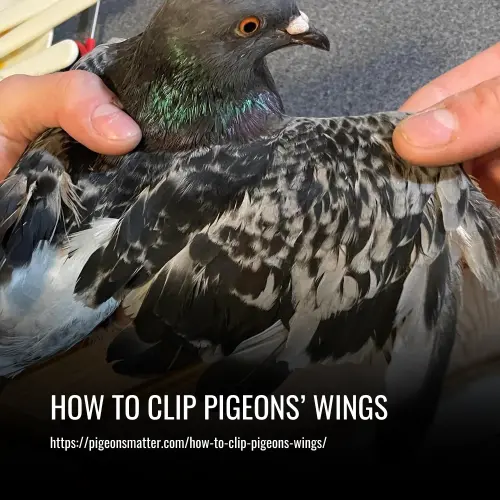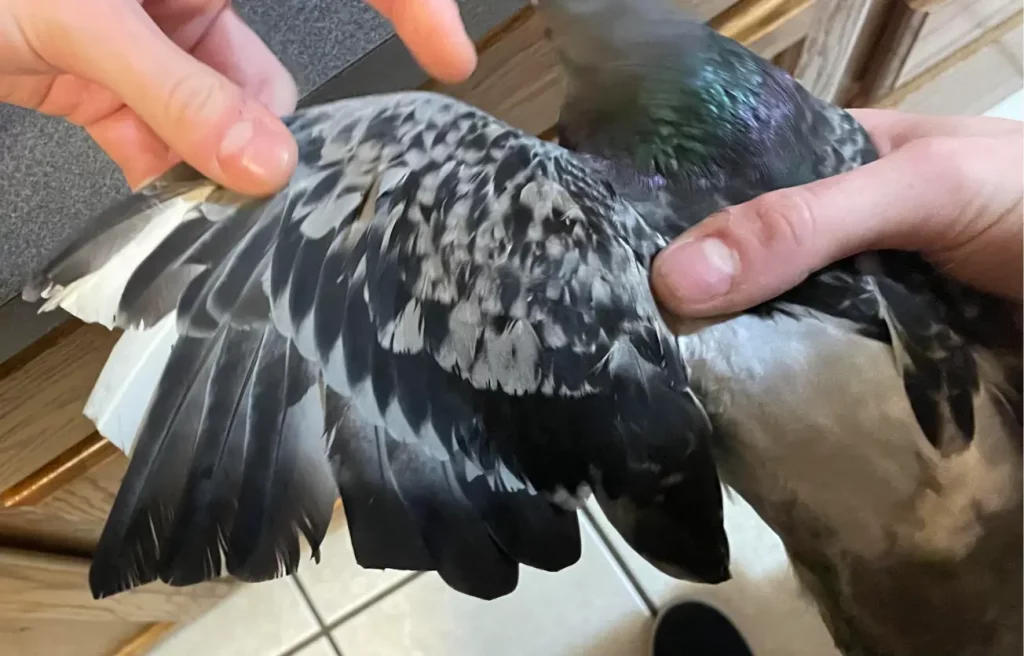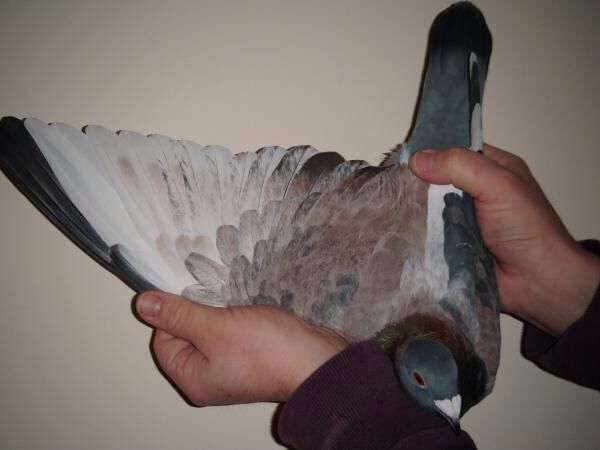How to Clip Pigeons’ Wings: A Complete Guide
This post contains affiliate links. As an Amazon Associate, we earn from qualifying purchases.
Pigeon owners often need to clip their birds’ wings to prevent them from flying away. This process is important for both the safety of the pigeon and the peace of mind of the owner. Clipping a pigeon’s wings can be a simple and quick procedure when done correctly, but it is essential to understand the proper technique to avoid harming the bird.
2 Methods of Clipping Pigeons’ Wings:
- 1. Trimming Fewer Feathers
- 2. Trimming Tail Feathers Along with Wing Feathers

How to Clip Pigeons Wings
Clipping pigeons’ wings is a common practice among pigeon breeders and experts. There are two main methods that are widely used:
1. Trimming Fewer Feathers
This method involves leaving the first couple of feathers from the outer side intact and cutting off the next three or four feathers halfway through. It’s important to be cautious with the length of the trimmed feathers to avoid hurting the pigeons. The number of feathers to be trimmed should be limited to three or five, depending on the breed, age, and growth of the pigeon. It’s also important to trim feathers on both sides to ensure even grooming.
2. Trimming Tail Feathers Along with Wing Feathers
In this method, the tail feathers and the first four or five feathers are trimmed. Unlike the first method, the first two feathers are also cut off in this approach, followed by the next two feathers. The angle of cutting the feathers is crucial.
It’s important to note that both methods require careful consideration and some experience in pigeon care. First-time pigeon keepers may find it challenging and should proceed with caution.

How To Trim A Pigeon’s Wings
Clipping your pigeon’s wings is an important task that must be done with care to ensure the safety and well-being of your bird. Here are the steps to properly secure and trim your pigeon’s wings:
1. Secure the Pigeon
Before beginning the wing trim, it is crucial to restrain the pigeon. If you have assistance, you can hold the bird against your body with one hand while using the other hand for the trim. However, if you are working alone, it is best to wrap the pigeon in a towel or blanket, creating a comfortable and secure grip.
2. Gently Spread Out the Wings
Carefully move the towel down to expose one wing. Slowly and gently extend the wing, ensuring that the pigeon remains calm and comfortable throughout the process.
3. Identify the Correct Feathers to Cut
When trimming a pigeon’s wings, only the primary flight feathers should be clipped. These are the larger feathers that overlap when the wings are closed. Avoid cutting the smaller overlapping feathers.
4. Start Trimming from the Wing Tip
Using sharp scissors, begin trimming the flight feathers. Some individuals prefer to leave the wing tip untouched for aesthetic reasons, while others cut through the wing tip. As long as the wings are evenly trimmed on both sides, balance will not be an issue. Gradually clip each flight feather, ensuring they are trimmed down to approximately 1cm before the shorter overlapping feathers.
5. Be Careful Not to Harm Your Pigeon
During the trimming process, it is crucial to watch out for blood feathers. These are newly formed feathers that contain blood vessels. Cutting a blood feather can result in bleeding and potential harm to the pigeon. To distinguish blood feathers, observe the stem of the feather where you may see blood flowing. If you encounter a blood feather, do not cut into it. Instead, immediately pluck it out with pliers or seek veterinary assistance.
Warning: If a blood feather is accidentally cut and bleeding, it will not stop on its own. Prompt action is necessary to prevent harm or death to the pigeon.
6. Make Sure the Wings Match
Once you have completed the trim on one wing, repeat the process on the other wing. It is vital to trim the same feathers to the same length on both wings, ensuring balance and symmetry.
By following these steps and paying close attention to the pigeon’s well-being, you can safely trim their wings. Remember to handle the bird gently and seek professional veterinary assistance if needed.
Safety Consideration of Clipping Pigeons’ Wings
When it comes to clipping pigeons’ wings, it’s important to exercise caution and not attempt it if you are inexperienced. Instead, seek assistance from a pigeon breeder or expert who can guide you through the process. However, if you do decide to proceed, here are a few key elements to keep in mind:
1. Avoid Plucking New Feathers
Some breeders and experts may pluck the old feathers in a pigeon’s wings for various reasons, such as giving them a fresh appearance. However, it is crucial not to pluck the new feathers as they are delicate and sensitive. Plucking them can cause pain and even result in bleeding. Leave this task to the experts who know how to handle it properly.
2. Be Careful Not to Cut off too Much of the Wings
Stories have circulated about young children who attempt to clip their pigeons’ wings to prevent them from flying away. Unfortunately, some end up cutting off too much of the wings, causing pain and discomfort to the birds. It is essential to exercise extreme caution when it comes to trimming the wings.
Always prioritize the well-being and safety of your pigeons when making decisions regarding their care.
Is It Good To Clip A Pigeon’s Wings
The Veterinarian Perspective: Veterinarians are increasingly discouraging the practice of clipping all or most of a bird’s primary feathers to prevent flight, as it can lead to injuries when the bird tries to fly.
Negative Consequences: Birds that are clipped in this manner often crash to the ground and may injure themselves when attempting to fly, leading to negative consequences for their physical well-being.
Overall Impact: While wing clipping may have been a common practice in the past, it is now being viewed as potentially harmful and unnecessary by many veterinarians.

The Benefits Of Clipping Wings
Clipping a bird’s wings has several potential benefits for both the bird and its owner. From reducing the risk of accidental fly-away to encouraging social interaction, there are various advantages to consider.
1. Accidental Fly-Away Risk Reduction
By clipping a bird’s wings, the risk of accidental fly-away is greatly reduced. This provides peace of mind for owners and decreases the chances of the bird getting lost or injured.
2. Less Risk of Damage
With clipped wings, birds are less likely to get into dangerous items or destroy household furnishings or woodwork. This can also lead to a safer and more controlled environment for both the bird and its owner.
3. Potential Handling Benefits
Clipped wings can provide handling benefits, such as when teaching a bird to step up. This can make training and interactions easier and safer for both parties.
4. Encouragement of Social Interaction
Clipping a bird’s wings can encourage some birds to interact with different people. This can lead to increased socialization and companionship for the bird while also creating a more enjoyable experience for its owner.
Overall, while wing clipping is a personal choice for bird owners, it can have positive effects on both the bird’s safety and its interactions with people. It’s important to carefully consider the potential benefits and drawbacks before making a decision.
FAQs
People cut pigeon feathers, a process known as wing clipping, to prevent them from flying away. This is typically done by avian veterinarians, breeders, or bird owners, and is commonly performed on pet birds like parrots. By trimming the bird’s primary wing feathers, it renders them temporarily unable to fly until they molt and grow new feathers. This practice is done to keep pet birds safe and prevent them from escaping or getting injured.
Yes, pigeon wings can regrow if they lose flight feathers. It usually takes about 6 weeks for the feathers to grow back. During this time, the pigeon may be unable to fly. However, if the pigeon is kept safe, it will eventually be able to fly again and be released.
Pigeons usually take 5 to 7 weeks to grow their tail feathers back. However, the exact time can vary depending on the size and breed of the pigeon. Factors like the pigeon’s health and diet can also influence how quickly its feathers regenerate.
Yes, you can clip pigeon wings at home, but it’s important to take precautions. It’s best to have your veterinarian teach you how to properly clip the wings and which feathers to cut. It’s also recommended to have someone assist you by holding the bird while you do the clipping. If the bird is not held properly, it can potentially hurt itself during the process.
The feathers of a bird that have been clipped will take between 6 and 18 months to grow back to full length. It is important to consider this timeframe before deciding to clip a bird’s wings, as it can significantly affect the bird’s ability to fly and its overall well-being.
Clipping a bird’s wings is not painful if done correctly. This process involves simply cutting the edge of their flight feathers to keep them from flying too high or flying out of the house. A better alternative can be taping the edge of their flight feathers with masking tape, which can also be effective in preventing flight without causing pain to the bird.
Some vets recommend clipping the wings of pet birds. It can help with training and socialization, and it’s not typically done to stop a bird from flying altogether. However, this is just one vet’s opinion, and other vets may have different views on wing clipping.
Conclusion
In conclusion, learning how to clip a pigeon’s wings is an important skill for bird owners. It helps to keep pet pigeons safe and prevents them from flying away. By following the proper techniques and guidelines, bird owners can ensure that the process is done safely and effectively.
Remember to consult a veterinarian or professional before attempting to clip a pigeon’s wings for the first time. Overall, clipping a pigeon’s wings requires patience, care, and attention to detail, but it can ultimately contribute to the health and well-being of pet pigeons.